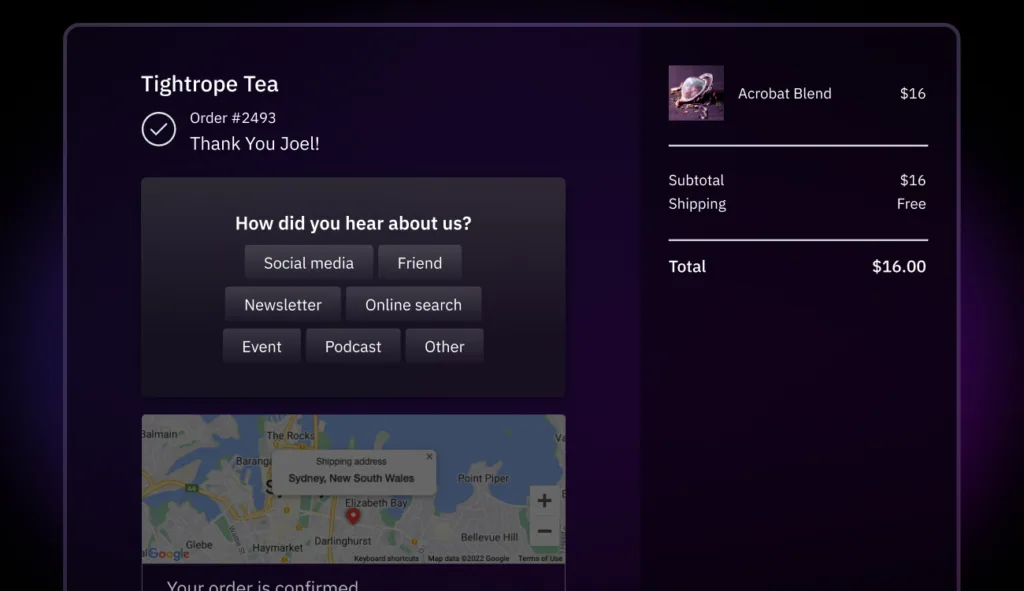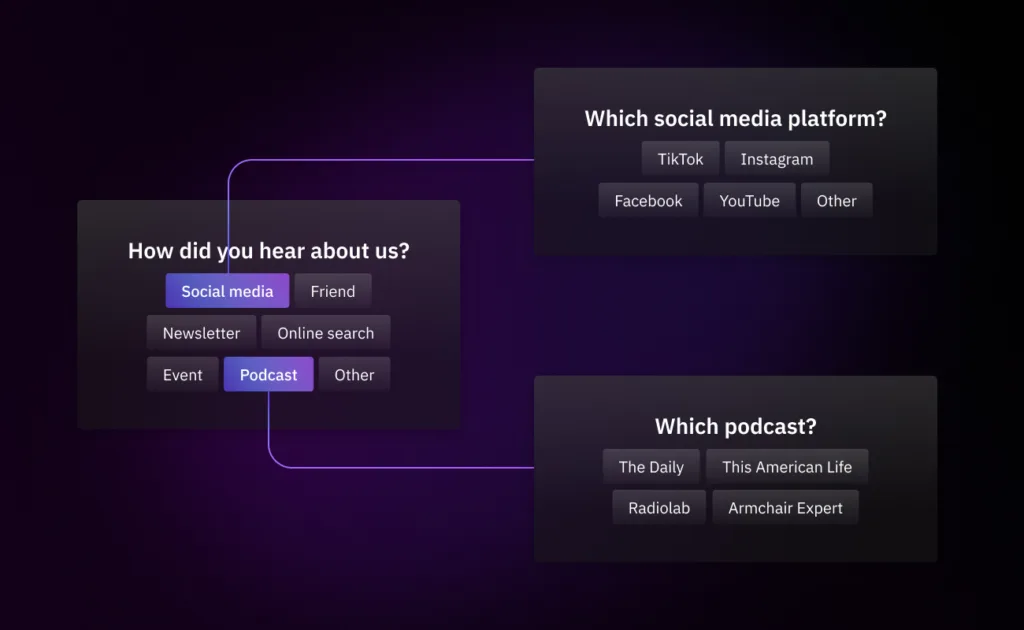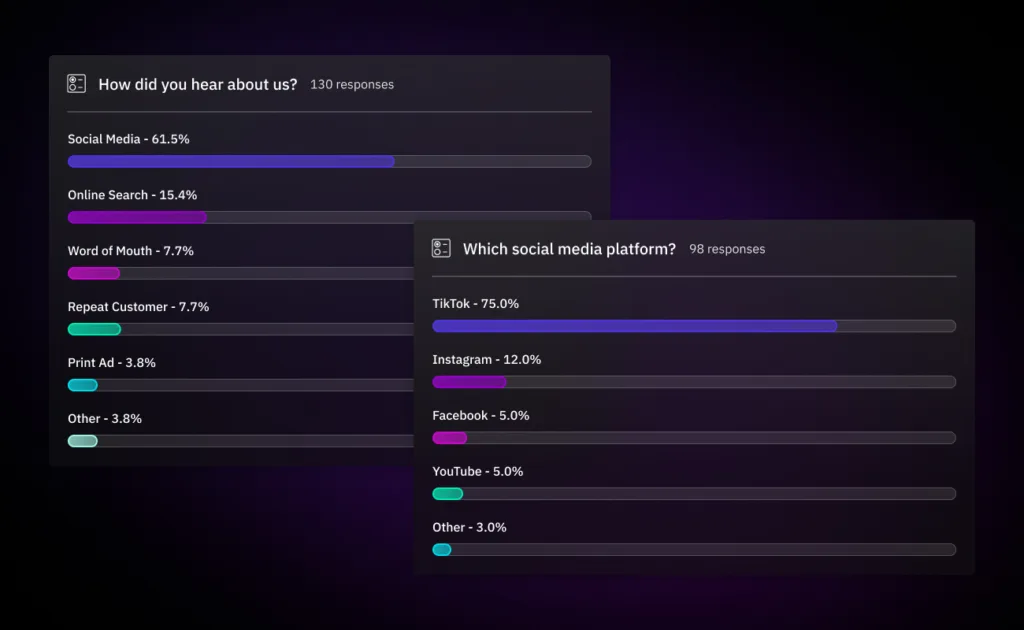“How Did You Hear About Us?” (HDYHAU) Surveys: Optimize Marketing Spend by Uncovering Your Most Effective Channels

Ecommerce marketing teams put a great deal of time and energy into driving online engagement and sales. But in order for these efforts to pay off, they need the ability to track the performance of campaigns and identify which channels are the most effective at reaching and converting new customers.
This is where post-purchase “How Did You Hear About Us?” (HDYHAU) surveys come into play. Put simply, when you can accurately pinpoint where the majority of your customers are coming from, you can allocate your budget accordingly and maximize the effectiveness of your marketing initiatives.
In this piece, we’ll explore the increasing importance of conducting HDYHAU surveys in more depth, as well as how to make the best use of the marketing attribution insights that these surveys generate. With that understanding, you’ll be able to better track the ROI of your marketing efforts and allocate your spend in a way that turns one-off purchases into sustainable customer relationships.

Why You Should Be Using HDYHAU Now
In recent years, the data privacy landscape has been undergoing a dramatic shift. With major platforms such as Apple and Google introducing considerably more stringent policies, merchants are gradually losing their ability to track exactly where their customers are coming from. This has become particularly true as it relates to popular social media channels, where the loss of data around customer acquisition cost (CAC) has become a source of frustration for many businesses and marketers.
“While Facebook used to be a primary channel for acquisition, rising competition and higher CPCs have forced brands to take more of a multi-channel approach to find finding new customers,” said Jon Snow, Founder & COO of The Snow Agency. “At the same time, Apple & Google privacy changes have made it more difficult for merchants to track marketing attribution, which has put the onus squarely on brands to ensure they can effectively identify where their customers are coming in from and double down on high performing channels.”
And while multi-touch marketing strategies can be quite effective, they can also result in multiple channels claiming attribution for the same purchase. Needless to say, these compounding hurdles make it incredibly difficult, if not downright impossible to evaluate the performance and accurately measure the true ROI of your marketing efforts.
In light of these challenges, the need for merchants to have a reliable independent mechanism for validating the performance of marketing campaigns is growing in importance. And what better way to uncover the driving influence of purchases than from the customers themselves?
Creating the Perfect HDYHAU Survey
HYDHAU and other post-checkout micro-surveys can be presented in a variety of ways. However, as with any survey, the specific format in which they are presented to the customer can have a significant impact on whether or not a customer chooses to volunteer these insights.
In today’s fast-paced digital environment, it should probably go without saying that convenience, efficiency, and overall user experience are paramount. Below you’ll find an example of a straightforward survey template that can serve as inspiration for your own post-purchase HDYHAU survey.
The Opening Question:
“How Did You Hear About Us?”
Pretty straightforward, right? While most How Did You Hear About Us surveys use the question verbatim, some marketers take a different approach based on their goals or other brand factors. For example, some HDYHAU surveys might start with a question like “Which of these things influenced your purchase decision the most.” And while this approach might provide interesting insights for specific purposes, in general, it’s always a good idea to go with the survey’s namesake for your opening question.
HDYHAU Response Choices:
Aside from allowing your business to hone in on the journeys your customers are taking to find you, HDYHAU survey data can also be a critical asset when measuring the efficacy of non-digital marketing channels such as podcast advertisements, conference and event sponsorships, and out of home (OOH) campaigns.
For your responses, you’ll want to identify the most likely channels that your audience came in through. HDYHAU surveys help you decipher which of your marketing channels are performing best, and give you the ability to attribute to specific channels with data that can be hard to track. These channels will often look like the below:
- Social Media
- Friend
- Podcast
- Event
- Newsletter
- Other
Whichever channels you choose, make sure you add an ‘Other’ option to your survey as it might allow you to identify channels that you didn’t know are driving customers to your business.

HDYHAU Follow-Up Questions:
Next, it’s important to make sure you have the right HDYHAU follow-up questions in order for you to hone in on the exact area driving traffic and eliminate the guesswork.
With solutions like Okendo Surveys, Question Logic tools allow you to drill further into where exactly your customers are coming from. For example, if they chose “Podcast” a follow-up question could display a list of podcasts you sponsor or are mentioned in for them to choose from, giving you a more precise idea of the channels driving customers.
As always, the more exact your insights are, the more action you can take on them.
What You Can Do with HDYHAU Channel Data
As we mentioned How Did You Hear About Us survey data allows you to understand the complexities of your multi-channel campaigns and gives actionable insights to take your marketing to the next level.

With the right tools and strategy in place HDYHAU survey data makes it much easier to:
- See the exact channels that your customers are coming in through.
- Cut back spend on channels that aren’t delivering the desired results.
- Rework the marketing budget and redistribute funds to channels that are performing effectively.
- Understand which channels have the potential for future growth and invest accordingly.
- Gain immediate insights into new channels/outreach campaigns to evaluate their initial performance and determine long-term efficacy.
Optimizing the HDYHAU Survey Process with Okendo Surveys
While many merchants are aware of the degrading attribution capabilities of popular online advertising platforms, fewer have the tools or know-how to confidently scale up high ROI marketing efforts and scale down poor performers.
This is exactly why Okendo Surveys was built: By minimizing the inherent complexity of gathering accurate attribution insights in the digital age, the Okendo Surveys solution not only allows brands to create and execute surveys, but it simplifies the ability for teams to optimize response rates and put survey data into action.
Key to this is Okendo Surveys’ highly customizable micro-surveys that can be sent across multiple channels. While many solutions only enable post-checkout surveys, Okendo Surveys’ post-purchase HDYHAU surveys can be delivered across three key channels: 1) post-checkout, 2) post-review, and 3) shareable links that enable surveys to be sent via email, SMS, etc. Taking a cross-channel approach increases the likelihood that you’ll receive the insights you need and opens up multiple touch-points for you to seek out feedback in highly relevant and contextual ways.
And once Okendo Surveys users have maximized their HDYHAU data collection, Okendo Surveys takes the complexity out of putting those insights into action. Through advanced filters that allow teams to isolate survey response data criteria, including customer properties, survey channel, date, and more, users can do away with messy spreadsheets and get a clear view of the areas and data that matters most to their business.
To overcome the rapidly evolving privacy landscape and digital marketplace, merchants increasingly need to cut out the middleman and speak directly to their customers about the effectiveness of their marketing campaigns. But rather than viewing this shift as a frustrating inconvenience, businesses can think of it as an opportunity to establish a post-purchase strategy that yields continuous insights, improves ROI, and provides consistently rewarding experiences for brands and consumers alike.